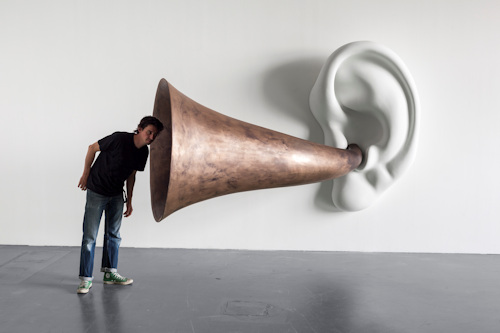
Vienna’s biggest museum can’t let Beethoven year pass without a suitable nod to the musical genius and cultural icon. Hence the ambitious Beethoven Bewegt exhibition at the Kunsthistorisches Museum (KHM).
- Uses an eclectic mix of historical and contemporary art to illustrate Beethoven’s enduring influence and build connections to his music and persona
- Dates: Sept 29, 2020 – Jan 24, 2021
- You need to book an extra time slot ticket to view
- See also:
Beethoven Bewegt

(John Baldessari; Beethoven’s Trumpet (with Ear) Opus # 133, 2007; Photo Timo Ohler © John Baldessari; Courtesy of the artist, Sprüth Magers and Beyer Projects)
Beethoven isn’t known for his series of oil paintings of Renaissance Italy (more’s the pity). So what’s he doing inside a major art history institution like the Kunsthistorisches Museum?
The answer lies on both sides of the equation.
First, Beethoven has long escaped the confines of his role as a mere creator of music. He is a story of triumph and tragedy, a personality, an icon, a brand, a humanist…a man who has influenced and inspired other creative talents and contemporary culture ever since his first notes escaped into the clamour of 18th-century Bonn.
Second, the Kunsthistorisches Museum (KHM) is no mere repository of art. As Vienna’s most prestigious museum, it also carries a mandate to encourage reflection, discussion, and new perceptions.
Combine the two aspects and you get the Beethoven Bewegt (Beethoven Moves) exhibition.
Concocted together with the Archive of the Gesellschaft der Musikfreunde in Vienna and curated by Andreas Kugler, Jasper Sharp, Stefan Weppelmann and Andreas Zimmermann, the exhibition offers the KHM’s own particular homage to the master in the year of his 250th birthday.
The essence of the exhibition is to juxtapose displays and installations that create dialogues and connections between Beethoven (his music and personality) and various works of art drawn from different genres and media. So you can “see” and “experience” Beethoven as much as “listen” to him.
As well as drawing on Beethoven-related material, the exhibition presents, for example, paintings, sketchbooks, sculptures, and videos.
The eclectic mix of artists so featured includes historical figures like Turner, Cossiers, Goya, Rodin, and Caspar David Friedrich, as well as contemporary creators like Idris Khan, Jorinde Voigt or Anselm Kiefer. Expect visual or conceptual art from such as Rebecca Horn, John Baldessari or Guido van der Werve. There’s even a performance piece created by Tino Sehgal.
The diversity of art and artists in itself seems to reflect the wide-ranging impact of one such as Ludwig van Beethoven.
My highlights
First of all, the exhibition includes many items that Beethoven purists should enjoy. The master’s own sheet music for sonatas and symphonies, for example. Or the flooring from his final residence. Or an ear trumpet he once owned.
As for the art, here my four particular highlights:
- Jorinde Voight’s drawings that turn different pieces of Beethoven’s music into mathematical soundscapes, the result looking a little (from a distance) like those wonderful susurrations of starlings you sometimes see. The variety of shapes so created seems to hint at the diversity of Beethoven’s skill.
- The etchings by Francisco de Goya from the end of the 18th century, produced after he (like Beethoven) lost his hearing. The depictions ooze with cynicism and social criticism, with a dose of the macabre added for good measure.
- Caspar David Friedrich’s Moon over the Riesengebirge from around 1810. The bright celestial object of the title seems so stark and demanding at the very centre of the wide picture of a mountainous landscape.
- Tino Sehgal’s adaptations of Beethoven’s music for voice, performed by two dancers in the last of the three galleries that make up the main exhibition. Ignoring the artistic value for the moment, it’s simply a startling experience in a museum otherwise known for its stillness and hushed atmosphere.
Dates and tickets
The Beethoven exhibition was postponed to autumn, so now runs from September 29th until January 24th, 2021.
A museum entrance ticket or an appropriate sightseeing pass gets you into the KHM, but you need to book a time slot to view the exhibition (extra €5 on top of the normal entrance ticket).
Be sure to pick up a (free) guide booklet at the entrance to the exhibition galleries.
How to get to Beethoven Moves
See the end of the main KHM article for travel tips for the museum.
The exhibition occupies part of the picture gallery on the first floor. Even if you take the lift, be sure to take a peek at the staircase, which is an artistic and architectural masterpiece in its own right.
If you like classical music, the Kunsthistorisches Museum also has an excellent collection of historical instruments (over the road from the main building in the Neue Burg) with more old instruments to be found in (somewhat unexpectedly) the Technical Museum.
Address: Burgring 7, 1010 Vienna